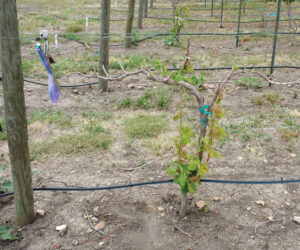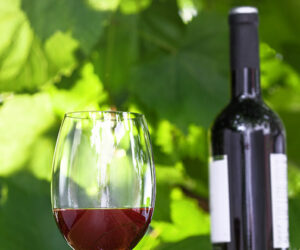There’s nothing like a big round number on the calendar to nudge us into a bit of change. And while we could have anticipated flying vineyard drones by 2020 that would tuck our shoots and pull leaves, we’re not quite there yet. So let’s take a quick look at what technology can offer the home viticulturist of 2020, how to start the vintage successfully, and then answer a few good questions from readers.
Here Come the Vineyard Robots! (Well . . . sort of . . . and probably not Meant for you!):
In an article in Wine Enthusiast magazine last April (https://www.winemag.com/2019/04/04/robots-taking-over-vineyards/) Melissa Kravitz discusses the ongoing attempts to use agricultural robots in vineyards, mostly in France. The robots can mechanically remove weeds, test for leaf-blade nitrogen levels, gather ripeness information, and plan harvests by row and by vine to achieve uniform ripeness. There are also attachments for ATVs and tractors that can spot-apply herbicide, pull leaves from the canopy, break fungicide droplets into micronized form, hedge the top of a vine row — and many other labor-saving tasks. But unlike how vineyards are first planted in a region — usually by small production home winemakers looking to make some good juice at home, technology is usually aimed at large-scale vineyards with huge bank accounts. In other words, this stuff is expensive and not really applicable, yet, for home and small-scale vineyard operations.
Some would argue that walking your vineyard every evening is as good as fancy sensors, but you can’t see soil moisture at 36-in. (91-cm) soil depth . . .
How about some good news? There is 2020 vineyard technology for you, though! Here are a few examples. As always, you can grow great wine using 19th and 20th century technology, and getting in the vineyard with your hands and a human crew may still produce the best wines in the world. But if you have a little too much money in your bank account, or you need some help with limited labor in your area, these tools may be just what you need.
- Power-pruners: Hands getting tired of making all those cuts? A few companies (e.g. Felco, Scotts, Echo) make electric pruners that will make those cuts easier. New safety features make them safer, but great care should be taken in establishing safety habits, as these bad boys can easily cut a finger off if improperly used. Keep them away from the kids!
- ATV with PTO (all-terrain vehicle with power-takeoff) and ATV implements: My consulting clients are often surprised when I suggest buying an ATV with a power-takeoff option (this is a spinning rod that powers sprayers, cultivator blades, and other time/labor saving devices). If you can afford to go with professional grade vineyard implements, you will save tons of time and money and get better results. The real issue? High cost and making sure you know how to operate these tools safely and legally.
- Survey drones/aerial photography/different light frequency: There was a time only 10 years ago when aerial photography and drone video cost thousands of dollars from professional companies. Now, chances are, your kids or nephews have aerial drones with HD cameras. These are a great way to assess a vineyard in full canopy — you can see struggling sections of the vineyard, irrigation leaks (showing overgrowth), and if you can get a camera with infrared or ultraviolet lens technology, you can see growth and vigor patterns, soil moisture, heat stress, and tons of data that can help you farm for consistency and quality.
- Sensors: Even though sensor technology is meant for large-scale vineyards, the same amazing technology is available to you at a price. Some would argue that walking your vineyard every evening is as good as fancy sensors, but you can’t see soil moisture at 36-in. (91-cm) soil depth, nor know nutrient status in your vines. You can get away pretty cheap here: Soil hygrometers (electronic) or irrometers (analog) will measure soil moisture at 12 in. (30 cm), 18 in. (46 cm), 24 in. (61 cm) and 36 in. (91 cm) depths. A few of each in your home vineyard will enable you to fine-tune watering for only a few hundred bucks. Taking petiole samples in your vineyard at bloom (according to the protocol of an agricultural lab such as Fruit Growers Laboratory [FGL] in California) will allow you to see your actual nutrient status at the most critical moment in the growing season, and will help you understand how nitrogen, potassium, and phosphorus (as well as micronutrients like calcium and boron) might be impacting your vineyard and wine. Measuring sun in your canopy with a fancy sensor may not be needed. We know from UC-Davis and Dr. Richard Smart that wine grape vineyards require no less than 10% of ambient sun to fleck on the fruit during the day, and that leaf plucking can be more severe (more open canopy) in cool-climate vineyards, and has to keep the fruit safely shaded/protected in the hottest climes.
- New fungicide and spray technology: Besides trying to get a spray rig that produces high pressure for full spray coverage, there are also tons of new amazingly effective fungicides, insecticides, etc. that may or may not be legal to spray where you live. My suggestion is to splurge on your spray rig and use the most professional materials allowed by your local agricultural office/commissioner.
Remembering 20th century canopy management: Even though we are now 20% finished with the 21st century (time flies when we’re drinking wine!), let’s not forget the important things we learned in the last two decades of the 20th century, mostly from Dr. Richard Smart’s Sunlight Into Wine, published in the early 1990s, which fundamentally revolutionized grape growing and canopy management in the world, starting in Australia. I strongly suggest reading Smart’s work and owning a copy, and if you have questions about canopy management, I strongly suggest you attend my Grape Growing Boot Camp at our WineMaker’s Conference this coming May (in San Luis Obispo, California I might add!).
And on to a few illustrative questions from readers in conspicuously non-traditional wine grape growing regions:
Question One: KANSAS!
This question is from C. Ellis and full disclosure, I have worked with Mr. Ellis as a client, visited his vineyard, and spent an entire day taking notes and making test cuts in the vineyard:
“Our three vineyards suffered massive cold damage last winter and spring, and we’re noticing that bud break is very sparse and inconsistent, with about 1⁄3 of the buds not showing any growth. Many vines (maybe 15%) aren’t waking up at all, and appear to be dead wood. What is your remedy for getting the vineyards back to producing great Crimson Cabernet and Cabernet Dore?”
Chris Ellis
Louisburg, Kansas
Mr. Ellis, first off I’m glad you chose hybrid varieties, as I believe they will recover better than a pure vinifera strain would, and I am impressed with your choice. I have looked over my notes from the site visit, checked my photos, reviewed my resources, and believe I’m ready to offer a plan for recovery. Some midwestern US winters are harsh and cold enough to cause permanent cold damage and vine death in a vineyard. Here’s what I would do next:
1-Year Plan:
- Encourage recovery from cold kill with pruning, fertilization, and agricultural molasses, and heavy cutting back and suckering . . . ASAP!
- Also ASAP, get soil and petiole samples to Kansas State. Perhaps also soil sample the northwest hillside soils for potential planting.
- Expect small amounts of under-ripe fruit to produce a rosé wine in small batch.
- Consider year one a regrowth/recovery year.
- Prune fairly heavily and professionally in winter
- Drink enough to get past the pain that nature provided.
2-Year Plan:
- Work hard in year one and give up some crop to make for healthier and more vigorous vines in year two, and plan to get enough crop to make a rosé, a little Dore (white) and a Crimson Cab with a bleed off of juice and potentially 5% Dore for color and aromatics.
- Work on winemaking, yeast, barrels, etc. to make sure this goes perfectly, or at least makes drinkable wine.
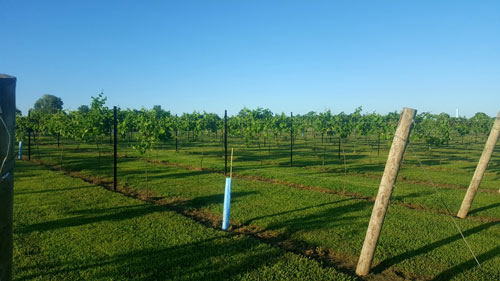
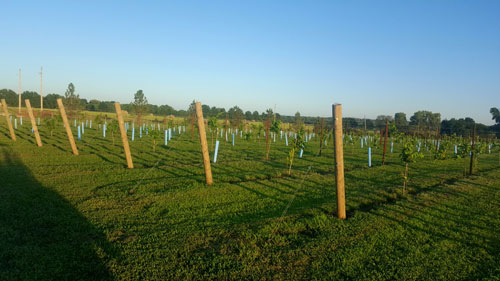
Varietal breakdown:
Vineyard 1: Crimson Cab, 4th leaf, c.600 vines, Norton rootstock
- Healthiest of three blocks as far as leaf area, but also the most impacted by fungal disease/pitting.
- May produce small amount of healthy fruit for rose’ production in year one.
- Main focus is to encourage recovery and health for year two and subsequent vintages.
- Immediately apply 1 cup split ½ cup per side of 19/19/19 or 15/15/15 fertilizer before next rainfall.
- Apply agricultural molasses at max rate ASAP if practicable.
- Trim off all dead wood and non-fruitful growth coming out of wood less than the diameter of a pencil.
- Continue normal spray routine for mildew/rot/insects.
- Weed with a hoe, weed before weeds seed, sucker all vines to 7 in. (18 cm) to the fruiting wire.
- Pack soil back around the vines with hoe.
Vineyard 2: Crimson Cab, 3rd leaf, Norton rootstock
- High amount of cold kill and damage to the vines that they are struggling to recover from.
- Cut all bare canes back to see where the green material begins. Cut off all wood that is brown and dead through the core.
- Cut vines back to just a nub if needed and apply a grow tube.
- Count missing/dead vines in mid-July and order/plant replacements in grow tubes.
- Immediately apply 1 cup split ½ cup per side of 19/19/19 or 15/15/15 fertilizer before next rainfall.
- Apply agricultural molasses at max rate ASAP if practicable.
- Continue normal spray routine for mildew/rot/insects.
- Weed with a hoe, weed before weeds seed, sucker all vines to 7 in. (18 cm) to the fruiting wire.
- Pack soil back around the vines with hoe.
Vineyard 3: Cabernet Dore, 2rd leaf, Norton rootstock
- Worst damage of three blocks due to young vines and thin stalks/trunks.
- Cut all bare canes back to see where the green material begins. Cut off all wood that is brown and dead through the core.
- Cut vines back to just a nub if needed and apply a grow tube.
- Count missing/dead vines in mid-July and order/plant replacements in grow tubes.
- Immediately apply 1 cup split ½ cup per side of 19/19/19 or 15/15/15 fertilizer before next rainfall.
- Apply agricultural molasses at max rate ASAP if practicable.
- Continue normal spray routine for mildew/rot/insects.
- Weed with a hoe, weed before weeds seed, sucker all vines to 7 in. (18 cm) to the fruiting wire.
- Pack soil back around the vines with hoe.
Mr. Ellis, I hope these suggestions get the vineyard back to a healthy balance.
Question 2: Alaska (no, really!)
I am growing vinifera varieties in greenhouses in Anchorage, Alaska. I have about half an acre of grapes and have 6 acres in which we grow flowers and fresh tomatoes and cucumbers. I have several varieties and have never had powdery mildew, and I know what it is since my family and I farmed 1,000 acres of table and wine grapes south of Bakersfield, California from 1950 to 1970 when I left and went north. The vines are spaced 5 ft. (1.5 m) down the row and 5 to 6 ft. (1.5 to 1.8 m) across so I can plant more vines in the limited space. Day temperatures are from 55 °F to 90 °F (13 to 32 °C). I irrigate via “trickle sticks” and we have plenty of water. The soil is pure sand so I bore a hole 14 in. (36 cm) in diameter 3 to 4 ft. (0.9 to 1.2 m) deep and back fill with used potting soil and fertilize with a balanced feed of 200 ppm nitrate, 50 ppm P, 300 ppm K, 300 ppm Ca, 1.5 ppm Fe, 0.80 ppm B, 0.25 ppm Zn, 0.25 ppm Cu, 1.5 ppm Mn, and 0.10 ppm Mo.; pH is 6.0 in the hydroponic feed program.
- What temperature is the minimum that should be allowed in the winter as the sunlight is so little that we get no heating units from it in the greenhouses in November, December, January, and February? We have plenty of gas heaters. I heat to 20 °F (-7 °C) and try to not let the temperature get any lower and so far the buds do seem to be fruitful. We allow for the possibility of freeze starting in October, although it’s in the 40s °F (5–10 °C) and very warm outside this fall, soon it will get really cold. We had a heat wave this past summer and it was very hot — we hit 90 °F (32 °C) and the greenhouses got up to 100 °F (38 °C) for several weeks! Fortunately we have plenty of water for the vines so I kept checking the tendrils daily. During the summer I allow the night temperatures to go down into the 50s °F (10 °C) although the nights are very short in July and August so it’s a short period when we hit 55 °F (13 °C) inside. What is the ideal daytime temperature during the growing season? We do get good color on black grapes and pH of Pinot Noir and Cabernet Sauvignon was 3.8 this year and TA 7.8 and Pinot Noir was picked at 22 °Brix; the whites were from 3.2 to 3.3 pH and TA of 6.6 to 6.8 and picked at 21 to 22 °Brix. At present, whites are at -1.0 °Brix and I am stirring on the less at 50 °F (10 °C). Reds are at -0.7 °Brix and going through malolactic fermentation (MLF) at 68 °F (20 °C) and have not been pressed. May press today.
- Can you suggest some varieties that are early and fruitful that will make good wine. My intention is to start a winery since we are the only state that does not have an estate-grown grape winery because one cannot ripen even the newer hybrids outside. Our vinifera vines start growing in late March when the sun heats up the greenhouses into the 70s and 80s °F (21–27 °C) during the day so we must turn the heat on when the sun goes down so the inside temperature does not go below 35 °F (2 °C) as night temperature outside can go below zero (-18 °C)!
All the clusters except Cabernet Sauvignon and Cabernet Franc set too many berries. I must comb each cluster right after fruit set to reduce the number of berries to about 50 to 70% or they will crack and rot during ripening. This is a labor-intensive task. Do you know any other way to reduce fruit set?
Fortunately I have over 60 years experience in viticulture and obtained a MS. at UC-Davis in 1967. Worked with Dr. Olmo, Dr. Weaver, Dr. Nelson, and Dr. Alley and many other great professors. Thank you in advance!
Mike M.
Anchorage, Alaska
Wow, Mike, this is indeed an operation you’ve got going there! Let me give you some straightforward and minimalistic answers for a very complicated issue. It should be noted that I am amazed by your early successes, and that you may be the only successful vinifera vineyard in Alaska, currently.
Question 1: Maximum photosynthetic capacity for V. vinifera is 87 °F (31 °C). Vine injury can occur under 10 °F (-12 °C), but more normally requires closer to 5 °F (-15 °C) or colder. A nighttime temperature of 20 °F (-7 °C) should be plenty warm during dormancy. Vinifera vines require 250+ hours of under 45 °F (7 °C) to reset bud fruitfulness.
Question 2: Pinot Noir ripens faster than just about any red wine varietal and Sauvignon Blanc, Pinot Grigio, or Pinot Blanc would be good for early ripening whites.
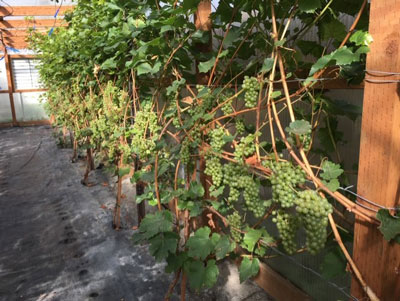
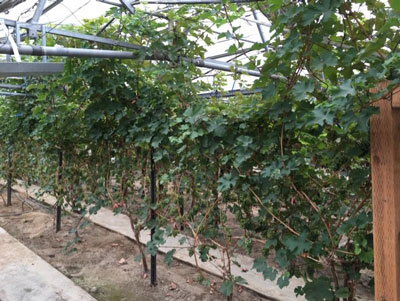
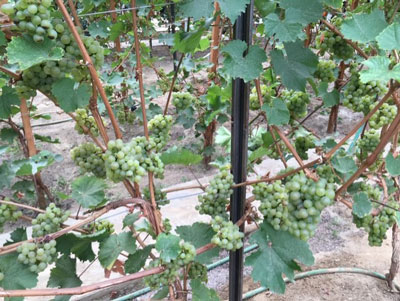
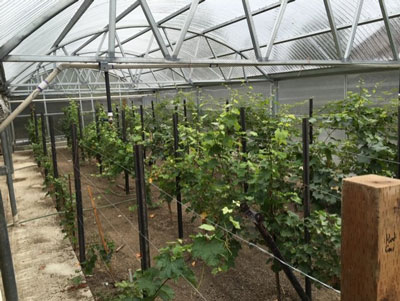
Combing to reduce set, although labor intensive, seems reasonable. The Cabernet family may require just too much heat for even your greenhouse.
I enjoyed seeing the pictures of your greenhouse vineyard (at right) and it looks like you’re really finding ways to make it work to get good, clean fruit. The lack of powdery mildew might be that the spores just don’t exist in Alaska yet. Consider yourself intensely lucky.
Thoroughly brilliant stuff you have going here!
Conclusion
2020 is no different than any other vintage. The difference is that we are starting a new decade, and the reset of decades gives us the chance to look back at the last ten years and find new solutions to ancient problems in the vineyard. As always, the focus is to make wine we are proud of and love to drink. With modern varietals, clones, wine grape growing and making technology, we have more tools than we ever had before, but also the most expensive tools.
Great wine is made by effort, passion, and often investment. Great technology minimizes the amount of toil and sweat that we leave in our backyards and small production vineyards. But I will also argue that the effort and labor we put into our vineyards and wine is the greatest gift that rows of grapevines can provide. Enjoy the wine, enjoy the labor, and use the technology that makes sense for you and your family.
Happy new decade and keep in touch!



